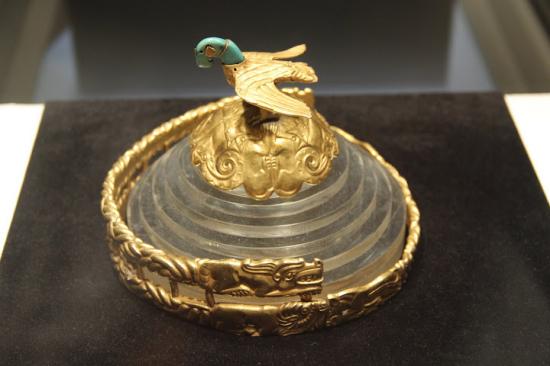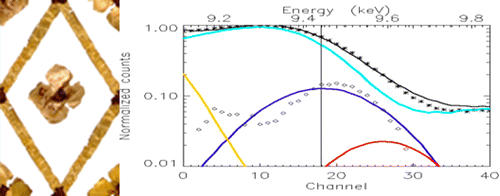Platinum levels suggest Xiongnu people of Mongolia produced their own gold jewelry
Sarah Everts
Source - http://cen.acs.org/articles/90/web/2012/12/Ancient-Xiongnu-Gold.html

Precious Metal - The Xiongnu people, who lived in Mongolia in the second and third centuries B.C., valued gold in the form of decadent jewelry and crowns. Credit: Gary Todd
Warrior nomads in Mongolia called the Xiongnu had a taste for the finer things in life, particularly gold jewelry, which they wore to their graves. Archeologists have wondered whether the gold objects found in second- and third-century B.C. Xiongnu burial sites originated from local deposits. Perhaps, researchers thought, the objects were gifts from the Chinese, who had a tumultuous relationship with their neighbors that alternated between warring and intermarrying.
Experiments using a synchrotron X-ray source now suggest that the Xiongnu gold originated from local panning in Mongolia instead of Chinese mines, says Martin Radtke, a physicist at Germany’s Federal Institute for Materials Research & Testing, in Berlin. Radtke’s team was invited to collaborate with researchers in Paris at the Center for Research & Restoration of Museums of France to pinpoint the likely geographical provenance of the Xiongnu gold..
Figuring out the gold’s provenance by a standard technique, such as studying the isotope composition of trace elements in the metal, was not possible, Radtke says. That’s because the method requires removing a small sample, which was not an option for the rare Xiongnu artifacts.
So the researchers turned to synchrotron radiation X-ray fluorescence (XRF), a noninvasive technique, and looked for the presence of platinum impurities in some 30 Xiongnu gold foils found in four tombs. They reasoned that if the Xiongnu had sourced the gold locally, they would have done so by panning, which leaves traces of platinum in the gold, Radtke says. Meanwhile if they found no platinum, the results would point toward a Chinese origin, since the mining techniques used by the Chinese during this point in history would have resulted in gold that was very low in platinum.
Unfortunately for the researchers, looking for trace platinum in gold using XRF is challenging because the signal for platinum is buried in the signal for gold. So the scientists employed a few experimental tricks to sidestep this problem.
First they adjusted the wavelength of the excitation energy to preferentially excite platinum signals. Next they measured or modeled the XRF spectra of all possible trace elements in the gold artifacts, such as tin, copper, and silver, and then subtracted these individual element spectra from the overall spectrum of the gold artifacts. The result was a spectrum that corresponded to that of platinum, suggesting that the origin of the artifacts was indeed the Xiongnu people themselves.
Beyond the Great Wall: Gold of the Silk Roads and the First Empire of the Steppes
Martin Radtke *†, Ina Reiche ‡, Uwe Reinholz †, Heinrich Riesemeier †, and Maria F. Guerra ‡
Anal. Chem., Article ASAP DOI: 10.1021/ac3025416 - Copyright © 2012 American Chemical Society
Abstract

Fingerprinting ancient gold work requires the use of nondestructive techniques with high spatial resolution (down to 25 μm) and good detection limits (micrograms per gram level). In this work experimental setups and protocols for synchrotron radiation induced X-ray fluorescence (SRXRF) at the BAMline of the Berlin electron storage ring company for synchrotron radiation (BESSY) in Berlin for the measurement of characteristic trace elements of gold are compared considering the difficulties, shown in previous works, connected to the quantification of Pt. The best experimental conditions and calculation methods were achieved by using an excitation energy of 11.58 keV, a silicon drift chamber detector (SDD) detector, and pure element reference standards. A detection limit of 3 μg/g has been reached. This newly developed method was successfully applied to provenancing the Xiongnu gold from the Gol Mod necropolis, excavated under the aegis of the United Nations Educational, Scientific and Cultural Organization (UNESCO). The composition of the base alloys and the presence of Pt and Sn showed that, contrary to what is expected, the gold foils from the first powerful empire of the steppes along the Great Wall were produced with alluvial gold from local placer deposits located in Zaamar, Boroo, and in the Selenga River.
Full Text HTML